Irving Brock and the Huron chiefs: a most chimerical idea
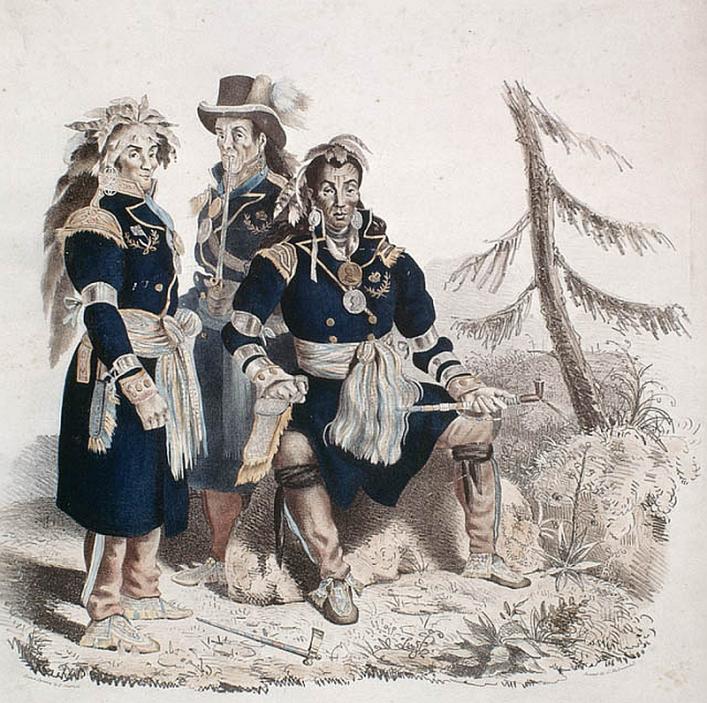
'The most interesting characters I ever saw—whose appearance here has been more beneficial than if volumes had been printed on Indian civilization.' By Dinah Bott, Priaulx Library.
Last Thursday, Sir John Chapman and Mr Irving Brock, brother of the Sir Isaac Brock who perished so gloriously in Canada during the last American War, presented the four Canadian chiefs, who had arrived in England shortly before, to the King at Windsor Castle. As soon as they saw his Majesty, they knelt, and His Majesty noticed medals of the late King hanging around their necks. They had been presented with these by Sir Isaac Brock, brother of our worthy Bailiff, and His Majesty told them that since they already had the picture of his father, they would not mind also wearing one of his, and he himself placed around their necks handsome gold medallions, which they kissed fervently. His Majesty also presented them with a print of a full-length portrait of himself, engraved after Sir Thomas Lawrence.* From the Gazette de l'Isle de Guernesey, 23 April 1825.
Irving Brock lived in Finsbury Square, in London,1 and took an active interest in politics. He was the author of various political pamphlets2 and translated a celebrated book, Bernier’s Travels in the Mogul Empire, into English from the French.3 We know more about the incident with the chiefs from a letter he wrote on the 12th April 1825 to Caroline Tupper, his neice, and which is reproduced by Ferdinand Brock Tupper in his The Life and Correspondence of Major Sir Isaac Brock.4
I went to Windsor on Wednesday last with the four Indians, accompanied by my friend Mr. W., to show them the castle, Frogmore, &c.; but the chief object, which I had secretly in mind, was to have them introduced to his Majesty. Sir John C[hapman], the late mayor of Windsor, assisted me very effectually, and the upshot of the matter is, that the king expressed his desire to see the Indian chiefs, although everybody treated this as a most chimerical idea. They wore, for the first time, the brilliant clothes which Mr. Butterworth had had made for them, and you cannot conceive how grand and imposing they appeared.
These, the first native American deputation to the British court, were the chiefs of the Lorette Hurons, known as the Wendat.5 With a population of only around 160, their hunting grounds were under constant encroachment from settlers. They were petitioning that land given to them by the French in 1651 and taken from them by the Jesuits in 1699, all rights to which had been lost since it passed into the hands of the Catholic Church in 1773, should be restored to them by the British. Their names were Nicolas Vincent Tsawenhohi, André Romain, Stanislas Koska and Michel Téachiandalé Sioui.6
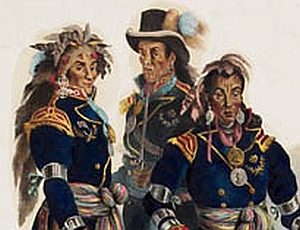
The main picture shows three of the chiefs in 1825, wearing some of the clothes they brought back from England.
The men of their tribe then quickly incorporated this type of coat into their traditional costume. The women dressed them up with magnificent accessories embroidered with moosehair. Leggings, moccasins, sashes (ceintures fléchées) and armbands of metal or birch bark covered with red stroud completed the ceremonial outfit of the men. This style spread through Wendake.7
This portrait, from the Canadian National Archives,8 shows clearly the two medals the chiefs received, one from Isaac Brock, the other from George IV. The Hurons had acted as guides to the British in 1810. The medals were large, apparently, because they particularly appreciated size over monetary worth. The chiefs were also very proud of the portraits of the King they were presented with, as Michel Sioui was still displaying his in 1863.9
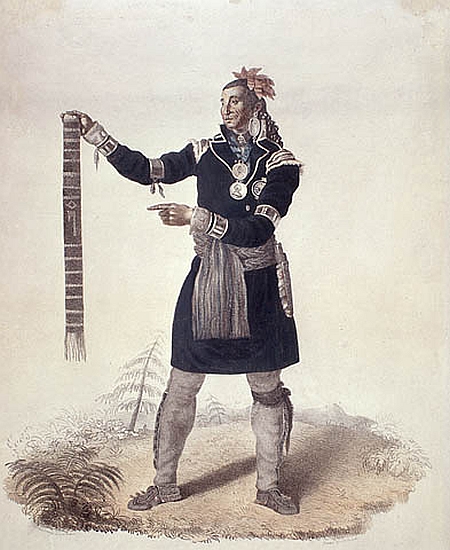
Nicolas Vincent Tsawenhohi (1771-1844) was the Grand Chief amongst chiefs and spokesman, and had his portrait engraved separately, holding up his wampum belt, with a tomahawk also given to him by Isaac Brock embroidered on his collar, in a print published in London in 1825.10 Sioui was the only Catholic amongst the four, although the Canadian First Nations peoples, inasmuch as they were interested at all in organised religion, showed a strong preference for Catholicism and tended to revert.
This delegation was not, however, Irving Brock’s idea; it came from the the Hurons themselves. They first petitioned for help in 1791, and made repeated calls on the Governor almost annually. Vincent became war chief in 1802 and Grand Chief in 1811. In 1819 he began to make representations to the Quebec Assembly in the Huron language; all to no avail. In 1817 Irving Brock's brother Savery had visited Canada to receive the grant of land made to him and his brothers in recognition of Isaac Brock’s contribution during the Canadian Wars. He had been fêted there very much as a brother of a deceased celebrity, and it was presumably in this context that Irving, resident in London and French-speaking, was asked to help the Hurons, perhaps by the philanthropist Walter Bromley. In his letter, Brock says that when the King asked about his connection with the Huron chiefs, 'I answered that they were recommended to my notice, because they had been invested with the medallions of his late Majesty by my brother.' The chiefs set out on 15 November 1824. They were received with great honour by Lord Bathurst, the Colonial Secretary, and their expenses were paid by the Government. They left in August, having learnt a great deal about the British political system.
FB Tupper includes an extract11 of a letter from Walter Bromley, dated London, 15th April, 1825.—From a Halifax N. S. newspaper.
The Indian chief [Nicholas Vincent?], who accompanied me to England, sailed in the Ward, for New Brunswick, a few days ago, loaded with presents to his family and people. I think his appearance here has been more beneficial than if volumes had been printed on Indian civilization, and I am in hope that on both sides of the Atlantic a general sympathy has been excited. The four Canadian chiefs have attracted much attention, and have been presented to his Majesty by the brother of the late General Brock; they are the most interesting characters I ever saw,—are extremely polite,—and speak French very fluently.
Walter Bromley and 'Mr Butterworth,' who provided the chiefs with their new frock coats, were both English humanitarians in the same mould. Bromley had been in the army and settled in Halifax, Nova Scotia, returning to England in 1825. Both he and Joseph Butterworth were evangelical Methodists. Bromley, the founder of the Halifax Poor Men’s Friend Society, set up a successful school in Halifax on the Lancaster model in 1814, teaching both poor white Acadians and natives.12 He wrote Two Addresses on the Deplorable State of the Indians (1815), and An Account of the Aborigines of Nova Scotia. Joseph Butterworth was an eminent law publisher, a radical MP for Coventry (1812) and Dover (1820), friend of William Wilberforce, and a very active supporter of missionary work.
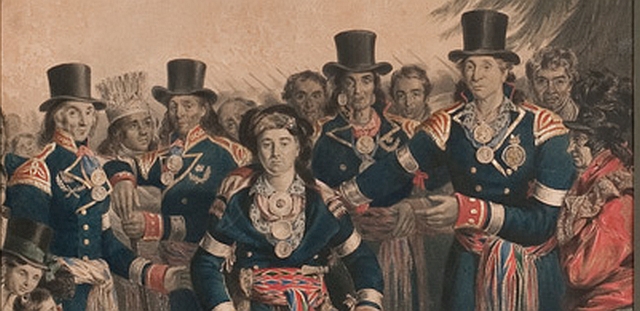
Despite the chiefs' being under the supervision of Lord Bathurst, Brock claimed he had had to ask the help of one of the King’s doctors and former Mayor of Windsor, Sir John Chapman,13 in order to secure the audience. Brock, with what reads as false modesty, writes that he felt a little embarrassed that he was singled out to speak to His Majesty, rather than Chapman. Windsor Castle garden was full of excited courtiers. Brock was amazed that the chiefs wore their hats while the King’s head was uncovered, but this does not seem to have worried the King, who addressed the chiefs in French. Nicholas Vincent Tsawenhohi made a rather long speech of thanks in Huron, which seems to have left the King a little nonplussed, and then one of the chiefs, probably Sioui, translated it into French. Irving Brock wrote it down later.
The Edinburgh Annual Register for 1825 continues the narrative:
His Majesty's answer to their address was most gracious. It was in French also, and in substance as follows:—He observed that he had listened with great delight to their affecting and loyal address ; that he had always respected the excellent people who formed the various tribes in his North American possessions, and that he would avail himself of every opportunity to promote their welfare, secure their happiness, and prove himself to be indeed their father.
His Majesty then conversed with them in the same language, in the most affable manner, for above a quarter of an hour. After seeing the interior of the Royal Lodge, the stables, the animals, and the birds, Sir Andrew Barnard conducted them to Cumberland Lodge, where a table, provided with refreshments, was prepared for them. On Thursday evening, they left Windsor for London, expressing their gratitude at having seen 'their great father, King George,' and the manner in which they had been received. Besides the medallions hung round their necks, his Majesty presented each of them with a print from his full-length portrait by Sir Thomas Lawrence. We understand the business which brought them to this country, was to recover possession of some lands that had been taken from them during the American war; and that a promise has been given them, that in case the same lands cannot be restored to them, they are to have a grant of another tract of land.
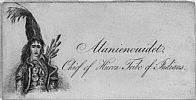 It appears that the chiefs got a taste for audiences and medals; the following year they received medals from the actor Edmund Kean (whose reception in Guernsey was ironically far from rapturous) and in turn received him into the Huron tribe.14
It appears that the chiefs got a taste for audiences and medals; the following year they received medals from the actor Edmund Kean (whose reception in Guernsey was ironically far from rapturous) and in turn received him into the Huron tribe.14
Ferdinand Brock Tupper includes this observation from F F de Roos' Travels in North America, in 1826.
This chief of the branch of the once great tribe of the Hurons visited England some time ago. I afterwards saw him in Quebec, and had a good deal of conversation with him. When asked what had struck him most of all that he had seen in England, he replied, without hesitation, that it was the monument erected in St. Paul's to the memory of General Brock. It seemed to have impressed him with a high idea of the considerate beneficence of his great father, the King of England, that he not only had remembered the exploits and death of his white child, who had fallen beyond the big salt lake, but that he had even deigned to record, on the marble sepulchre, the sorrows of the poor Indian weeping over his chief untimely slain.
It would appear that Nicolas Vincent was indeed an excellent diplomat! The chiefs were, however, unsuccessful in their direct request, but Vincent's persistence and celebrated visit to England meant that eventually the Wendat gained some sort of guarantee of lands for hunting in 1829. After Vincent returned to Jeune Lorette he drew up a detailed map of the area, known as the Vincent Plan, with the object of establishing his people's claims and rights, but, sadly, may have instead simply enabled the authorities to exploit his ancestral lands more efficiently.15
* Jeudi, Sir John Chapman et M. Irving Brock, frère de Sir Isaac Brock qui, dans la dernière guerre d’Amérique, a glorieusement péri au Canada, ont conduit les quatre chefs Canadiens, arrivés depuis peu en Angleterre, à la Loge Royale au palais de Windsor, et les ont introduits à la présence du Roi. Dès qu’ils ont vu Sa Majesté, ils se sont mis à genoux, et Sa Majesté ayant aperçu à leurs cous le médaillon du feu Roi dont ils avaient été investis par Sir Isaac Brock, frère de notre estimable Baillif, elle leur a dit que puisqu’ils avaient le portrait du Roi son père, ils ne seraient peut-être pas fâchés de porter le sien, et elle leur a passé elle-même au cou de beaux médaillons d’or, qu’ils ont baisé avec transport. Sa Majesté a donne aussi a chacun une gravure de son portrait en pied, d’après Sir Thomas Lawrence. Gazette 23 April 1825.
1 Irving was one of the four surviving brothers of Sir Isaac Brock; the others were John Savery, who lived in Guernsey in the house known as 'Detroit' on the Grange (named after a fort in Canada which played a major part in his brother's military career; now Grange House), Daniel de Lisle Brock, the very effective Bailiff, who lived at Bon Air, and William Brock, who inadvertently bankrupted the family by buying in Isaac's commissions, intending them as gifts, and then being unable to pay for them when the loans were unexpectedly called in. There is a privately published pamphlet by Irving Brock in the Library's Brock files, disclaiming any knowledge of, or complicity in, the fall of William's company, the House of Brock & Le Mesurier. Irving lived at Christopher-Street, Finsbury Square, for a long period of his life. On 1804 he married Frances Longley, daughter of Betheia and Robert Longley (d. 1813), a merchant who also had a residence there. Irving Brock died at Bathwick, and left all his goods to his wife in a will made in 1832, including his house in Doughty Street. After Isaac died unmarried in 1812 the four brothers were each granted an annual pension of £200 by the Government in recognition of Isaac's services, as well as receiving land in Canada, most of which they eventually sold (again, see the Brock files).
2 He wrote pamphlets such as The Patriots and the Whigs the most dangerous Enemies of the State; IN WHICH is recommended a new and more efficient mode of Warfare, printed by Richardson, 1810 (2nd ed.). This sought to denigrate the party of 'appeasers' of Napoleon and advocated a much more aggressive campaign against him: 'I would not content myself with singeing a few yards of his coast; I would destroy a great many of his towns. I would teach him to tremble at, to hate rather than, as he now does, despise, the name of England. I would revisit on his own head the horrible, the unprovoked calamities which he has inflicted on unoffending countries; and by appeasing the manes of the unhappy citizens of Saragossa, I should not doubt I was doing what was most acceptable to the God of Justice', pp. 50—51. Writing from Quebec in 1809, Isaac Brock's view of the pamphlet was favourable: 'Several copies have, within a few days, been in circulation here. Savery speaks of a letter you received in consequence from Lord Melville. I hope you will not fail in sending me a copy, as I am all anxiety for your literary fame. As you differ in sentiment to the Edinburgh Review, I hope that you have made up your mind to an unmerciful lashing.' (F B Tupper, The Life etc. see n. 4 below, p. 49). He also appears to have been the author of A letter to the inhabitants of Spitalfields, on the character and views of our modern reformers, which was published anonymously in 1817 by F.C. and J. Rivington.
3 'Correct and elegant in every respect:' the Monthly Review's verdict on Brock's translation of Travels in the Mogul Empire, by Francis Bernier, London: Pickering, 1826. This was first published in French in 1670; Brock translated and annotated it, producing a very successful edition. Unusually, the Priaulx Library does not have a copy of this work, but we do have an original 1671 edition of another of Bernier's books on the same subject, The history of the late revolution of the empire of the Great Mogol: together with the most considerable passages, for 5 years following in that empire. To which is added, a letter to the Lord Colbert, touching the extent of Indostan; the circulation of the gold and silver of the world, to discharge itself there; as also the riches, forces, and justice of the same: and the principal cause of the decay of the states of Asia. By Monsr F. Bernier, physician of the faculty of Montpelier. English'd out of French, printed [by S.G.], and sold by Moses Pitt at the White Hart in Little Brittain, Simon Miller at the Star in St. Pauls Church-Yard, and John Starkey at the Miter near Temple-Bar, 1671; and Niccolò Manucci's Storia do Mogor, or Mogul India 1653-1708, translated by William Irvine, London: John Murray, 1907.
4 The Life and Correspondence of Major-General Sir Isaac Brock, K.B.: interspersed with notices of the celebrated Indian chief, Tecumseh. Edited by his nephew Ferdinand Brock Tupper, London : Simpkin, Marshall, 1845. Henrietta Tupper, Ferdinand's daughter, wrote of him in 1882: '[The medal for] for Detroit has been for many years in our possession, my father being the then eldest son of the general’s elder sister, not one of Sir Isaac's nine brothers having left a son. We have also the coat in which he was killed, the handkerchief with his blood, and I believe every scrap of paper relating to him, for my father [Ferdinand Brock Tupper] was an intense hero-worshipper, and his gallant uncle was his chief hero. From my cradle I was taught every interesting particular concerning my great uncle, and Detroit and Queenston have always been household words in our home.' From Lady Edgar, "General Brock's Portrait", The Canadian Magazine 31, May 1908, pp. 262-5.
5 The Wendake had helped the British in 1810 in their war against the Americans, acting as guides through the forested lands between Halifax and Quebec. The Huron-Wendat are still a thriving people. A museum to celebrate their history was opened in 2008, and on their website can be seen one of the George III medals given to the chiefs by Sir Isaac Brock. Their original home was at Lake Wendake in Ontario, but they were forced to flee and settled at Jeune Lorette, in Quebec, retaining their ancestral name of Wendat or Wendake. The four chiefs have descendants living today. This first delegation was followed by another in December 1825 from amongst the Hurons, led by chief Tahunrenche and the Honourable John Neilson.
6 'Chief Nicolas Vincent, a civil and military chief, was known as a great diplomat, the first native person to speak before the Assembly of Lower Canada, and the first to do so in the Huron language. He was declared a person of national historic importance by the Canadian government in 2001. In honour of this highly respected leader and chief, the community had his private house (c. 1820) restored and converted into a cultural centre for the benefit of the entire community and region. La Maison Tsawenhohi provides a lasting testimony to the heritage of a proud nation.' He received visiting dignitaries and celebrities at the house.
7 The Huron-Wendat made a good living selling beautiful craft objects to tourists during the 18th and 19th centuries. See The Huron-Wendat craft industry from the 19th century until today, by Linda Sioui.
8 The Canadian National Archives, to which belongs the copyright of all the illustrations in this article, also have an 1840 portrait of Nicolas Vincent in snowshoes by Sir Philip Bainbrigge, son of Rachel Dobrée of Guernsey.
9 According to Léon Gérin who wrote The Huron of Lorette in the year 1900, 'Thomas Tsioui, a typical old Huron (about 80 years of age), living on the 1600 arpents reserve. Three of his sons still living are hunters as much as conditions permit; he himself spent the greater part of his early life in the woods, and at one time he was a noted long distance runner at the Quebec and Montreal exhibitions. He was very proud of a picture hung up in the best room of his house, a portrait of George IV, a royal gift to Michel Tsioui (my host's father), when as one of the Huron delegation he visited London in 1824.'
10 In the Winkworth collection at the Canadian National Archives. The print is after an original painting by Edward Chatfield.
11 The Life and Correspondence of Sir Isaac Brock, (see n. 4 above), p. 366.
12 His Royal Acadian School had 400 pupils, under the auspices of the British and Foreign School society. Two Addresses on the deplorable state of the Indians, by Walter Bromley, late paymaster of the 23rd Regiment Welsh Fusiliers, London, 1815, printed for the benefit of the Indians.
13 Knighted at Windsor in 1823 for services to the King, Chapman was one of the first three hundred founder members of the Royal College of Surgeons. He had been employed by William IV as his surgeon and had an special interest in mental health, being one of the three partners in the Great Fosters lunatic asylum, which was run on enlightened lines and may have been where George III was treated during his illness.
14 'On 5 October, Edmund Kean met four Huron chiefs and gave to each a medal made by a goldsmith called Smillie. In return, he was received into the Huron tribe under the name of Adanieouidet (or Alanienouidet) and was apparently given the Huron costume and arms. After leaving Quebec City, Kean travelled to New York and from thence to England, in December 1826. Both in New York and London, it amused him to wear his Huron costume and he was so proud of his Indian name that he had it engraved on the back of his visiting card. In London he had his portrait painted in Huron costume and had the result engraved. [This portrait hangs in London's Garrick Club.]' From the Canadian Adaptations of Shakespeare Project.
15 See the Wikipedia article (in French).
[DAB]
